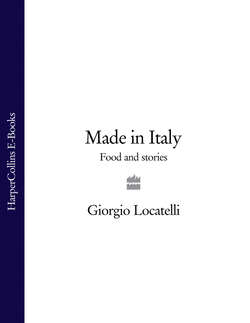Читать книгу Made in Italy: Food and Stories - Giorgio Locatelli - Страница 10
The traditional Italian meal
ОглавлениеIn Italy the concept of the ‘starter’ – individually plated dishes that you eat by yourself, just you – is quite a modern thing. Only in the last twenty years or so have restaurants started putting them on the menu. Traditionally, after the antipasti the real ‘starter’ was the pasta course, or first plate (i primi piatti). Then came the second plate (i secondi piatti), which would be meat or fish, and, to finish, fruit or a dessert (i dolci).
When I look at the books I have of old regional recipes, no mention is made of ‘starters’ as we think of them today. One of the books I love most is La Scienza in Cucina e l’Arte di Mangiar Bene (Science in the Kitchen and the Art of Eating Well) by Pellegrino Artusi. All Italian cooks know about Artusi – he was a great gourmet and one of the first writers to gather together recipes from all over Italy. He published the book himself back in 1891, in the days when Italian food was considered a bit vulgar in ‘smart’ society because the food of the royal courts was French.
Artusi spent twenty years travelling around Italy and his knowledge of regional produce and cooking was remarkable. His stories are full of beautiful descriptions and witty comments, sometimes using old Italian words that I have to look up. I keep his book in my office in the kitchen at Locanda to research ingredients and old recipes. But even Artusi has only a short section on ‘appetisers’, which is really just an acknowledgement of the moment before the meal when you show off your capacity to bring out food of a high quality. (Interestingly, he says that in Toscana they did things differently from other regions and served these ‘delicious trifles’ after the pasta, not before.) Artusi talks about various cured meats, caviar and mosciame (salted and air-dried tuna), but the only ‘recipes’ he gives for appetisers are a selection of crostini: fried bread topped with ingredients such as capers, chicken livers and sage, or woodcock and anchovies.
Traditionally, the kind of antipasti you ate was determined by where you lived. Around the coast there would obviously be more seafood, while inland there were cured meats. Every region would have different breads to serve with the antipasti: light, airy breads in the North, white unsalted bread in Toscana and enormous country loaves made with harder flour in the South – fantastic for bruschetta, which these days has become rather elevated in restaurants, but is really just chargrilled stale bread with a bit of garlic and tomato rubbed over it and some oil drizzled on top.
Even now, food in Italy is very regional, but after the Second World War, when everything became more abundant and people began to travel more, some chefs started to be a little inventive and borrow ideas for their antipasti from other regions, and from the street food you see cooked in cities such as Napoli by vendors with gas burners on trolleys: arancini (rice balls), crocchette (mashed potato croquettes), panzerotti (little pasties filled with meat, cheese, tomatoes or anchovies, then deep-fried), mozzarella in carrozza (mozzarella ‘in a carriage’ – deep-fried between slices of bread), and frittelle (fritters filled with artichokes, mushrooms or prawns).
